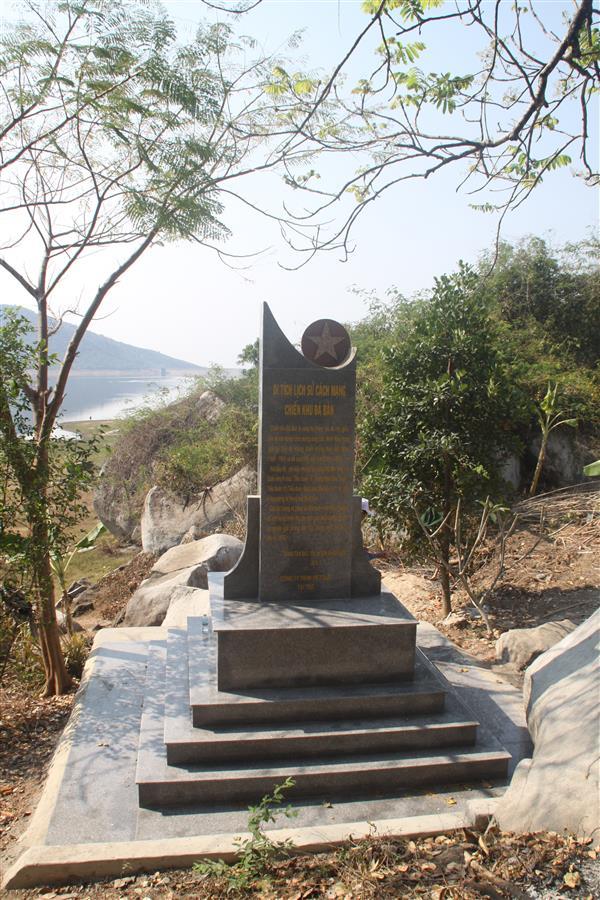Description
Historical relic Location of Da Ban revolutionary base in hamlet 5, Ninh Son commune, Ninh Hoa town.
In 1950, the US imperialists were about to intervene in the Indochina war, the resistance war moved to a new stage. In order to meet the needs of the resistance war, we must organize well political and military forces, logistical means, especially the blood vessels. Therefore, revolutionary activities at Hon Heo base became narrow, easily isolated and no longer suitable. In fact, from the end of 1949, road traffic to Hon Heo was often congested. Resupply by sea from Phu Yen is no longer safe. The province's forces are passive on food issues, greatly influencing the direction of the general movement, especially in the southern districts. In early 1951, the Provincial Party Committee sent a division to explore and survey the Da Ban area to build a revolutionary base.
Da Ban has a favorable geographical position and natural conditions, located far from the plain, connecting with the bases of Hon Lon in the South, Hon Heo in the East and the large free zone of Inter-zone 5, 7 The area of Da Ban area is hundreds of km2 wide with immense primeval forests stretching on both sides of Da Ban river with streams, dense forests, caves, combined with nature. In the center is Da Ban valley, the fertile flat land can grow rice and crops to settle food on the spot. Therefore, during the two resistance wars against the French colonialists and the American imperialists, Khanh Hoa Provincial Party Committee chose this place to build a base to prepare for a long-term resistance. By March 1951, all the agencies of the Provincial Party Committee, the Administrative Resistance Committee (UBKCHC), and the Provincial Army were stationed at Da Ban, building this place into the base of Khanh Hoa province and for both Bac Khanh districts.
The base is divided into 3 zones: North, Central and South. Each zone has government officials and mass organizations like a village, under the management and administration of the Bases Committee. All the youth and production camp campers were organized into guerrillas, armed with guns, grenades, bombs, mines, etc. to do the task of guarding against the enemy. The whole base has two mobile concentrated armed squads led by Mr. Tran Dinh Xuan, responsible for guarding the main roads leading to the base, organizing the information system, giving alarms by alarms every day. when there are planes, enemy infantry infiltrates the base. Protecting from afar there are guerrillas in peripheral areas, posts, observation posts of reconnaissance, military intelligence of districts and provinces.


(Introduction of the Da Ban Revolutionary Base - Photo: Nguyen Chi Khai)
On a large base, with tight defenses by lines of wars, mines, food and food sources, there was a relatively stable solution for the development of work at the base. The army units of the province and Bac Khanh have stable footholds, organize army and cadre training, perform a combination of combat and construction, combat and production, and have good conditions for rearing. nursing and taking care of wounded and sick soldiers. There is a Party school of the province, a typographic printer, a forge for farming tools, a military workshop to repair weapons, a hospital, a prison for prisoners of war, etc. arts festival. Da Ban base was formed as a foothold, a common support for the whole province, having a direct influence on the Bac Khanh movement.
Located about 3km from the lake bed containing Da Ban (the area formerly known as Ghe wharf) towards the center of the Da Ban revolutionary base is Da Trai area consisting of many flat rocks stretching on the right bank of the Da Ban river, Around there are many small stream branches, fertile flat land, dense forest trees.


(Stele relic of Da Ban resistance base - Photo: Hoang Quy)
Da Trai site is a place to commemorate many events of typical historical value. Especially, here, in December 1951, Khanh Hoa Provincial Party Committee held the second Congress of Khanh Hoa Provincial Party Committee. The congress took place in the context that the whole Party had a clear direction in guiding ideology to bring the resistance war to victory.
The 2nd Congress of Khanh Hoa Provincial Party Committee was held with important significance. Political Report of the Provincial Party Committee with the title: "Examination of war leadership of Khanh Hoa Provincial Party Committee". The Congress affirmed the practical effect of Da Ban base on the province's resistance movement. The work of building the base and building the force has made certain progress. The direction of the Provincial Party Committee and the districts and township committees began to change in thought, working style and working style, showing that they are closer to the work, closer to the movement than before. The overwhelming majority of cadres, party members and armed forces have the spirit of enduring hardship and sacrifice. The congress deeply studied reality, drew experience on the issues of building the mass base, building the paramilitary and armed forces, building the Party, leading the struggle, thereby orienting the whole Party. The whole people will continue to improve the Party's leadership capacity, the entire people's fighting strength, and promote the spirit of solidarity of the whole nation. The Congress elected 15 outstanding comrades to the Executive Committee to lead and direct Khanh Hoa troops and people to repel the invading French colonialists, contributing to the overall victory of the country.
With typical historical value, the relic has been ranked by the People's Committee of Khanh Hoa province, Decision No. 282/QD-CT.UBND, dated February 3, 2021 ranked as a provincial historical - cultural relic. .
NGUYỄN CHÍ KHẢI